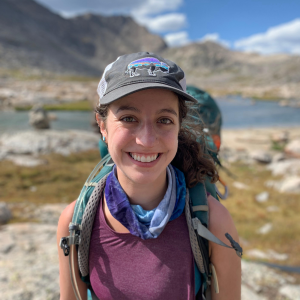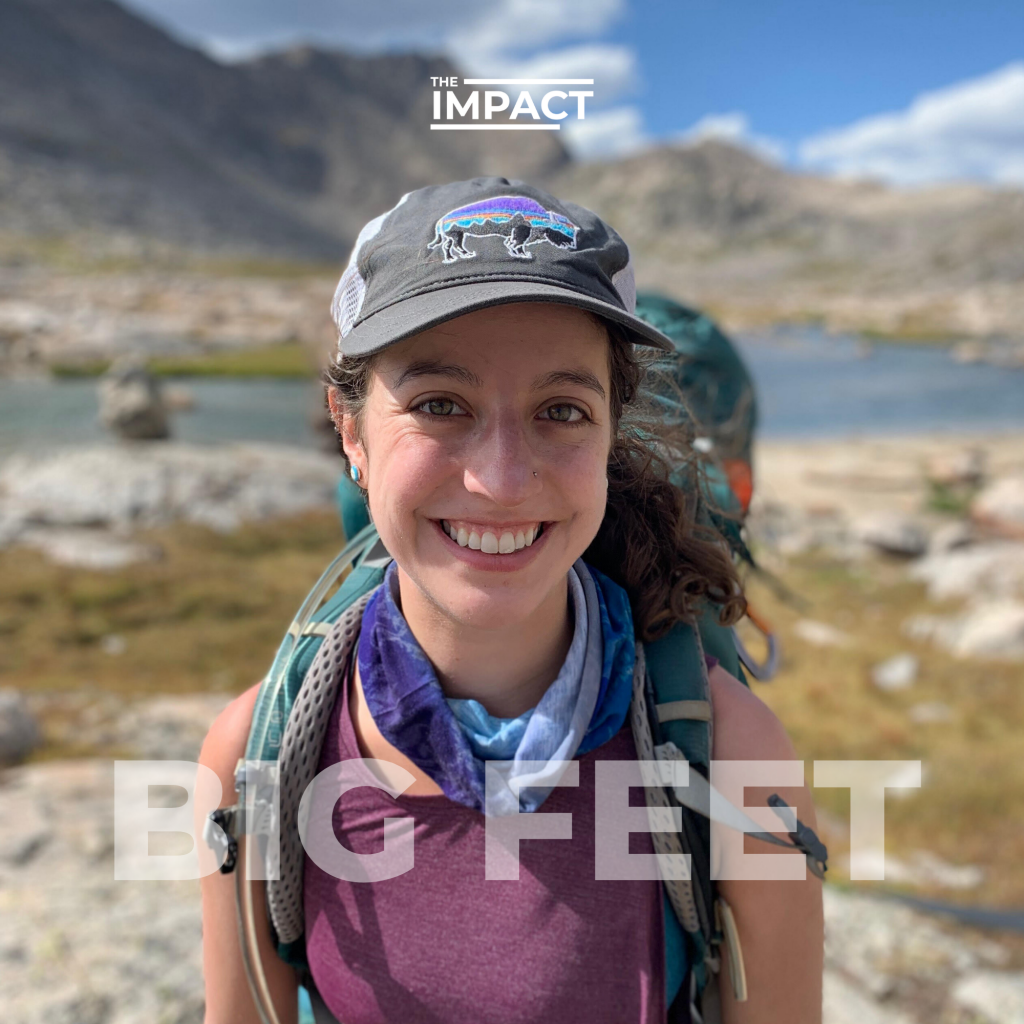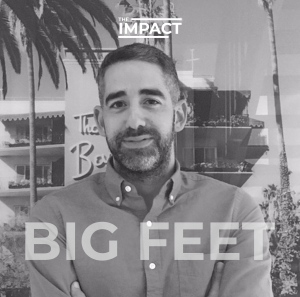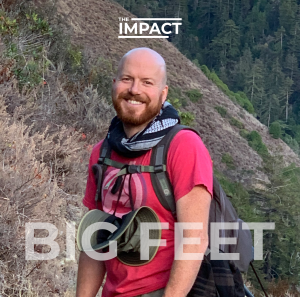Ian Sumner 0:01
I’m just starting to think of all the little tiny plastic stuff in different places that that yeah, it’s really
Victoria Beall 0:07
Floss even.
Ian Sumner 0:09
Oh, God.
Victoria Beall 0:14
It’s everywhere.
Ian Sumner 0:17
No, okay. This week on big feet, I’m drowning in plastic, and why is it everywhere here to help me out? Victoria deal.
Okay, so I did a really, really rough calculation of my carbon footprint for 2019. And I needed some help understanding it so I called up a friend Victoria Beale. So, Detroit you’ve been eliminating single use plastics from your life and using your Instagram at environment Toria it’ll be in the show notes to focus on making bees and sort of other nifty tips that you’ve picked up along your journey more available to everyone. And I know we’re gonna have to talk about my physical footprint of you know, plastic trashed. But first, I converted my rough carbon footprint from metric tons to pounds. And I don’t I don’t like that number because pounds like in like I know how much a pound is right
Victoria Beall 1:11
right a metric ton is kind of hard to envision.
Ian Sumner 1:16
Yeah, and so I don’t have like a quite a good like visual on like saying, Oh, it’s this skyscraper tall or whatnot. But I worry that it is kind of a skyscraper because it’s 22,921 pounds is what I came up with.
Victoria Beall 1:31
Well, bet a lot of that was from air travel.
Ian Sumner 1:34
Over half of it is yeah, so I guess I take this number, which I feel like is really big. And I know
Victoria Beall 1:43
it’s bigger. Yeah. Yeah. Wow. So it’s really crazy because we think about in a series of a couple flights, we have used 5.4 times the amount of energy as I use in my apartment for An entire year. Wow. How much how much is from your car?
Ian Sumner 2:05
So, I did a couple while I was driving up and down between LA and the Bay Area. Pretty much all year. Oh, I did a couple more than a couple trips up to Oregon. And back in February of 2019. I did that road trip all the way to Canada and back from LA.
Victoria Beall 2:21
Wow.
Ian Sumner 2:23
Yeah, so I ended up driving a little under 20,000 miles in the year
Victoria Beall 2:26
and that’s with an energy efficient car. Right? The Prius?
Ian Sumner 2:30
Yeah, so that equals out to around 8063 pounds of co2
Victoria Beall 2:38
that is really much lower than I was expecting.
Ian Sumner 2:41
Yeah, it’s great for 20,000 miles. still awkward in the grand scheme of things. But I know from reading your Instagram and having you as a friend, that this isn’t the full picture. So jumping over to the other foot. I know you’ve been focusing a lot on it. Information surrounding our physical footprint. So what do I need to be investigating and considering on this?
Victoria Beall 3:07
Yeah, I love that way of framing as a physical footprint. Because again, I think it starts to become really abstract. Like I was saying, like, really any object is something with the carbon footprint. And the way I mean, I personally choose to think of a lot of this in terms of just like the physical waste it generates. I guess like, you know, we’re talking about footprint to me it has a lot of connotations of like energy and energy usage. And I think that is still like really abstract to people. Like even you know, like, What does what is 16,000 pounds of carbon? Like really mean? Um, yeah,
Ian Sumner 3:52
like, I have no idea how to, I have no idea is a skyscraper Is it a house? Is it
Victoria Beall 3:56
exactly what is that? What are its effects, but I think when you think Both things in terms of the physical product of waste that you’re producing. It’s much easier for people to conceptualize and relate to
Ian Sumner 4:10
and can also have a huge impact, right?
Victoria Beall 4:12
Yeah, it’s, it’s really attainable. For a lot of people, it is certainly not attainable for everyone. I don’t think everyone could realistically live like a zero waste lifestyle. But for people like you and I, who are, you know, members of the middle class coming from, like a relatively like, well to do like background, these are things that are just really easy to do. Something that I’m particularly passionate about is food waste. Not just the actual wasting of food itself. You know, we waste 30% of the food that we produce, but all of the things encompassed in it. six out of the top seven most commonly found plastic Like in our oceans and on our beaches are things that come from food. So we’re talking the plastic cups, straws, the cutlery, the like styrofoam packaging that your bell peppers come in, like, bags, takeout bags,
Chip bags, bottle caps, coffee stirs coffee cups.
Those by far and away make up the majority of the plastic waste that we create. It makes sense, right? Like, what is the thing that every single person on the planet is doing the most every single day?
Ian Sumner 5:34
That’s what we’re built to do.
Victoria Beall 5:36
You have to do it. Yeah, we got it.
Ian Sumner 5:38
It’s the one. It’s the one thing
Victoria Beall 5:40
you gotta do eating and drinking. Yeah. Um, so the amount of waste that is being produced from that is just like truly mind boggling. So I think if there’s only one part of your life that you could choose to focus on for reducing your waste. That’s the part to focus on.
And then yeah, like when you’re out in the world, like when you’re
Purchasing anything, you know, like really anything you consume. So clothes, books, records, like, just like any object that you own has a carbon cost to it.
Ian Sumner 6:16
You didn’t think of it that way. But it really is everything that we interact with has a carbon cost now, doesn’t it? Anything else I should be keeping an eye on.
Victoria Beall 6:24
So I think another important thing for you to be looking at is food. Right? So when we’re looking at like some of the leading causes of climate change, right, there’s a lot of rhetoric around the consumption of meat. Because meat farming has led to like a ton of deforestation. It’s just really resource intensive, you know, to grow a lot of crops to feed the animals and then the process of actually like, slaughtering and transporting animals as opposed to plants is a lot more intensive. So the carbon cost of consuming an omnivore diet I think is really important. I think there’s a significant difference between someone that eats all varieties of meat versus someone who is even just pescetarian to someone who’s vegetarian, someone who’s vegan. So obviously, a lot of the really like hot millennial conversation has been around the straw, right? The war on the plastic straw. And yeah, that is without a doubt important. I personally am just not a person that’s ever used straws very much. I was gonna say like, I feel like the only time I used straws is they put the drink on the counter and already has one in it. Exactly. Like I get a Jamba Juice and they have a straw. It’s good that there’s attention around this particular piece, but it’s really like coffee cups, like a lot of cups, cups and bags. Really. I have the top of the UN. What they say at the top seven found pieces of garbage in the environment, cigarette butts, followed by plastic bottles, bottle caps, like grocery bags, plastic bags, takeout bags, coffee cups and then straw straws are the most common.
Ian Sumner 8:06
Okay, so we’re at least attacking one of those. The lowest of the top seven. It sounds like
Victoria Beall 8:13
the lowest of the tops.
Ian Sumner 8:14
Thankfully, a lot of cities are starting to ban plastic bags but coffee cups. Are you talking about like a like a paper Starbucks
Victoria Beall 8:20
cup? Yes. So pretty much all drink cups that are quote unquote paper are typically lined with a film to make them more like heat resistant or like less prone to tearing. And that is almost always some sort of plastic that then renders some unrecyclable I thought it was like a wax type of thing on the inside. Nope. It’s plastic. No, really. Yeah. I feel
Ian Sumner 8:47
like I’ve been lied to.
Victoria Beall 8:48
Yeah, it is. And I think there’s a lot of greenwashing in the food packaging industry. You know, you’ve probably seen such a rise like those compostable plastic cups. You know, they’ve got a cute little group. Leaves printed on them and you’re supposed to not feel guilty throwing those away. Oh yeah, I know those that so they’re just straight up plastic. It’s pretty much I mean, I think nine out of 10 companies it’s like a some sort of modified plastic it’s not like a true bio plastic and even bio plastics are. So compostable plastics are really problematic because they’re only compostable under really specific conditions that many many cities don’t have the infrastructure to support it really I believe San Francisco is actually one of the cities that does ever this awesome article the other day from the New York Times saying how San Francisco is like at diverts 88% of its waste compared to the national average, which was like 30 something nice, okay. So you know, your standard compost pile is able to take care of plant matter pretty easily. You if you want to start taking care of things like meat and bones, I’m sure you’ve probably heard like you need a really, really big really hot compost pile. Yeah, I’ve heard and the same goes for these. Like really rigid bio plastics or like compostable, like clods and things like that. Like they just need larger, hotter compost piles, which a lot of cities don’t have because it requires like some serious like industrial infrastructure support.
Ian Sumner 10:14
Interesting. Yeah. I was assuming like, you know, that all the city composts, we’re going to be you know, these big, robust, really hot, tall, steaming piles of, you know,
Victoria Beall 10:27
And that’s if your city has compost, right, true, right? Yeah.
And then if it ends up in a landfill, then it’s effectively just another piece of trash like things don’t compost on their own in the landfill. Oh, compost requires very specific conditions. It’s not just like, you throw a banana on the ground and it’s gonna become soil. Like compost requires like oxygen and nitrogen rich materials and like other organic matter to support the process of becoming compost. So in a landfill, you’ve got a lot of inorganic Matter, so it’s pretty much impossible for things to compost there.
Ian Sumner 11:03
Gotcha. So looking at or figurative or even literal banana in a landfill,
Victoria Beall 11:08
it’s gonna break down, but it’s not going to become like a healthy usable soil. Hmm. I understand where like the good intention is coming from with bio plastics, but it’s still better to just use a reusable alternative.
Ian Sumner 11:24
So I’m hearing eliminate single use plastics, and I’m on board. But I haven’t been talking about how prevalent they are and others everywhere in our lives. So how did you approach this because it feels kind of daunting.
Victoria Beall 11:36
Yeah, so I definitely took a much more radical approach that I think is like reasonable possible or desirable for a lot of people. I think I kind of purged everything at once. And not to say that like I was doing an excellent job before but like I definitely it wasn’t as drastic of a change for me as I think it would be for a lot of people just because you know, I’m a single person without kids. But yeah, so I started this whole thing by participating in the plastic free July challenge last year in 2019. And I just sort of started exploring around on social media reading a lot of blogs of like, quote unquote zero wasters, zero waste communities called and seeing what they do and you know, starting with some of the really easy stuff there’s this awesome store called the package free shop it’s a like women run business that just sells household items like entirely without packaging like you go to the store and like you just can buy like a soap bar like nothing no paper just like a naked so far.
Ian Sumner 12:51
Oh my god, I forgot about that to my my soap comes wrapped in plastic. I didn’t even think about that.
Victoria Beall 12:56
I know rightly think you’re winning and there’s always some sort of caveat to it so frequently. So when I started this, like, plastic free July challenge, like every day, I tried like every day or every other day I tried to focus in on the new subject and I would adopt whatever change it is.
Ian Sumner 13:16
I was like, I’m just starting to think of all the little tiny plastic stuff in different places that that yeah, it’s really floss even. Oh, God.
Victoria Beall 13:30
It’s everywhere.
Ian Sumner 13:35
Okay.
So the big things I can be doing that yeah,
Victoria Beall 13:40
I think the step is just taking a look at what you have, thinking about what you actually need. I think you know, sort of going hand in hand with making not just substituting what you have with the reusable alternative, but also considering where there space to produce right One of the other big three R’s. And I guess also, once we figured out what we need, and replace it with a sustainable option, we’re finishing what we already have and making sure we’re not just throwing it out. Exactly. Because then then you’re just wasting stuff. And I think it’s also important to consider like the end of life cycle for all of your items and how to dispose of these things responsibly. Like you can’t just put a deodorant stick in the recycling, and it’s going to get recycled, like that’s considered an object that can’t be recycled in traditional recycling. So figuring out how to responsibly dispose of the things you have, and then taking the step to taking stock of just what you have, what do you use every day? More, you
Ian Sumner 14:42
start to make switches. And I guess the sort of selfish economic argument is that it’s actually cheaper as well to reduce
Victoria Beall 14:50
right yes, that’s an example of something that was immediately like a ton cheaper for me. I think the thing that is difficult about going Really ham on all of these switches all at once is that it’s a really large, upfront cost. But in a lot of ways, like I’ve already gotten, like more than that amount of value out of it. And I’d argue that every single sustainable switch is going to be cheaper for you in the long run. It’s just whether you’re willing or able, you know, to front that cost.
Ian Sumner 15:22
So I feel like I kind of have a list that I’m walking away with.
Victoria Beall 15:27
Yeah, I think you’ll find that it’s one of those things that really snowballs really quickly. Like once you’ve made a couple of changes, and if you’re really going with the mindset that this is something that’s important to you, you’re going to just find so many other things that you want change and start to get creative with the like alternatives you could be using. I think also just the important thing to always bear in mind is, you know, don’t you don’t need to buy stuff. Like you’re saying that doesn’t have a place in your life. So, don’t go around buying a bunch of cool new, like eco friendly gadgets if like, it’s not realistically something that you’re actually going to need or want or use, tying back in that theme of like reducing. That’s an important part of it.
Ian Sumner 16:14
And it’s good to know that I don’t have to go full off the grid hermit in the mountains, living off the land in order to be
better or close to maybe neutral.
Victoria Beall 16:29
Yeah, I mean, I think it’s really important to remember right? The term sustainability, right is all about sustaining. What do you need and what can you get that’s just going to help you continue to live your life and as seamless and as least trashy as you possibly can. And, you know, there’s always going to be ways in which we can be better and once we have governments that are actually you know, making these much more accessible to people
was just gonna be a better place.
Ian Sumner 17:00
I know I have a lot of work to do.
But I feel like we’re setting in a really great place. And I have my homework. Thanks for starting me out on on this, I guess journey. We’re gonna we’ll see how this
Victoria Beall 17:11
goes. It’ll be great. And I’m sure you’re gonna find things that I don’t even know about and just gonna keep learning.
Ian Sumner 17:18
I’m excited. Thank you for teaching me all this awesome stuff.
Victoria Beall 17:23
Yeah, thanks for thanks for asking questions.
Ian Sumner 17:26
All right, we’ll talk soon.
Victoria Beall 17:27
All right. See ya.

Victoria Beall
Victoria Beall (@environmentoria) is a UX Designer in New York City that focuses her work on using the intersection of technology and design to create tools for positive social impact in the realm of environmental sustainability. Check out her list of low and zero waste alternatives to the single use products in our lives everyday.





